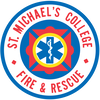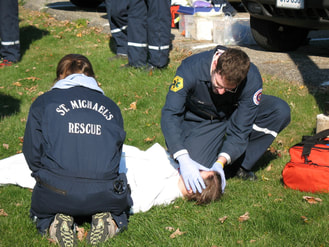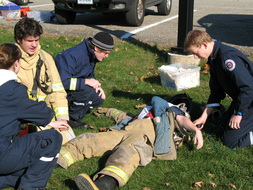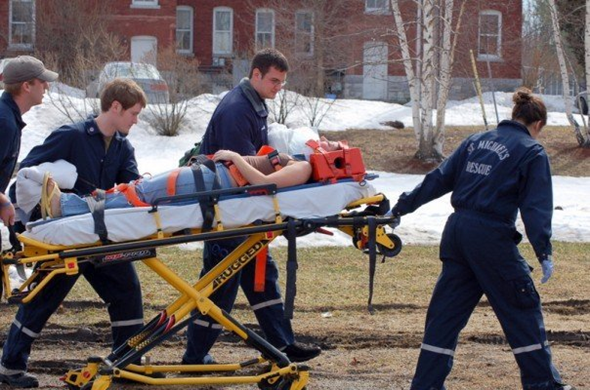THE ROOKIE CLASSRookies learn the basics of EMS through a series of lectures taught by various members of the department and alumni, and become CPR-certified. Rookies are also given the task of completing a series of psychomotor skills sheets, interviews with every member of the department, and skills designed to teach them about the rigs. The rookie class is generally designed to introduce new members to the department and the work of emergency service.
|
Upon successful completion of all of these skills sheets and the course, rookies are given the opportunity to “try-out” for the department. Try-outs are comprised of both psychomotor and standard test questions, while the results of each candidate are confidentially discussed and voted upon by the constituency.
RIDING POSITIONS
FOURTH: The “fourth” on the truck is a learning position and is required to be CPR certified. A fourth's role includes helping the third complete assessments, giving psychological first aid, setting up oxygen, and assisting with any task that another crew member may need help with. While acting as a fourth, most members take the EMT class that has been newly piloted at SMC.
As a fourth becomes more experienced and proficient with skills, he or she is allowed to “third train”. As a third trainee, the member is taught through direct experience, with the third-trainer acting in a facilitative or observational role (depending on the proficiency of the third trainee).
As a fourth becomes more experienced and proficient with skills, he or she is allowed to “third train”. As a third trainee, the member is taught through direct experience, with the third-trainer acting in a facilitative or observational role (depending on the proficiency of the third trainee).
|
THIRD: Upon successful completion of the EMS course at UVM, certification as an EMT, and approval of the training committee (which reviews the performance of each member during a monthly meeting), a third trainee becomes a third. The role of the third is to take the initial set of vitals, assist the crew chief with assessments, provide interventions, direct the fourth, and coordinate the safe transition of the patient to the ambulance. A third will be enrolled in the AEMT (advanced EMT) class at UVM, or the newly piloted AEMT class at SMC for further training and certification to perform more interventions.
|
A proficient and experienced third will be designated as third trainer by the training committee. A third trainer with outstanding dedication, excellent psychomotor skills, and leadership capabilities can then begin to train as a crew chief upon recommendation of the training committee. A CCIT (crew chief in training) completes a series of skills designed to teach radio proficiency and etiquette, state and district protocols, direct communication with the hospital staff through both radio/telecommunication, and documentation of calls. Upon completion of these requirements, successful live training on “live” calls, and approval of crew chief trainers and the training committee, a CCIT becomes a crew chief.
|
CREW CHIEF: The crew chief is responsible for the successful overall operation of the squad on and off calls. As one of the most experienced and proficient members of SMRS, a crew chief is expected to act as a leader and representative to everyone the crew may come into contact with. A crew chief is frequently an AEMT or EMT Intermediate, capable of starting IV's and performing interventions such as advanced airways and administering nitroglycerine, aspirin, D50, normal saline and glucagon.
|
The main role of the crew chief is acting as the bridge between the patient and the hospital by identifying problems, ordering correct interventions, and relaying results to the hospital. Upon arrival at Fletcher Allen ED, the crew chief will give a verbal report to the receiving staff and then write a full length report documenting the entire call.
DRIVER: The driver is in charge of the safe and efficient arrival of the crew to the scene and then to the hospital. The driver is the liaison between the equipment on the truck and the scene, making trips back and forth to shuttle necessary items. The driver is responsible for the safe placement of the ambulance on scene, ensuring visibility to other drivers and a clear route towards the hospital. Acting as the crew member that is least directly involved with patient care, the driver adds another set of eyes to the overall scene, looking for potential hazards and other things that the rest of the crew may not see when they are treating the patient.
To become a driver, a trainee will complete an intensive training program that requires a candidate to complete a requisite number of “on the road” hours, as well as memorization of roads and landmarks in SMRS's entire service area. As driving is commonly the most dangerous aspect of a call, drivers are held to a high standard of proficiency and knowledge in every skill before they are allowed to drive.
To become a driver, a trainee will complete an intensive training program that requires a candidate to complete a requisite number of “on the road” hours, as well as memorization of roads and landmarks in SMRS's entire service area. As driving is commonly the most dangerous aspect of a call, drivers are held to a high standard of proficiency and knowledge in every skill before they are allowed to drive.







